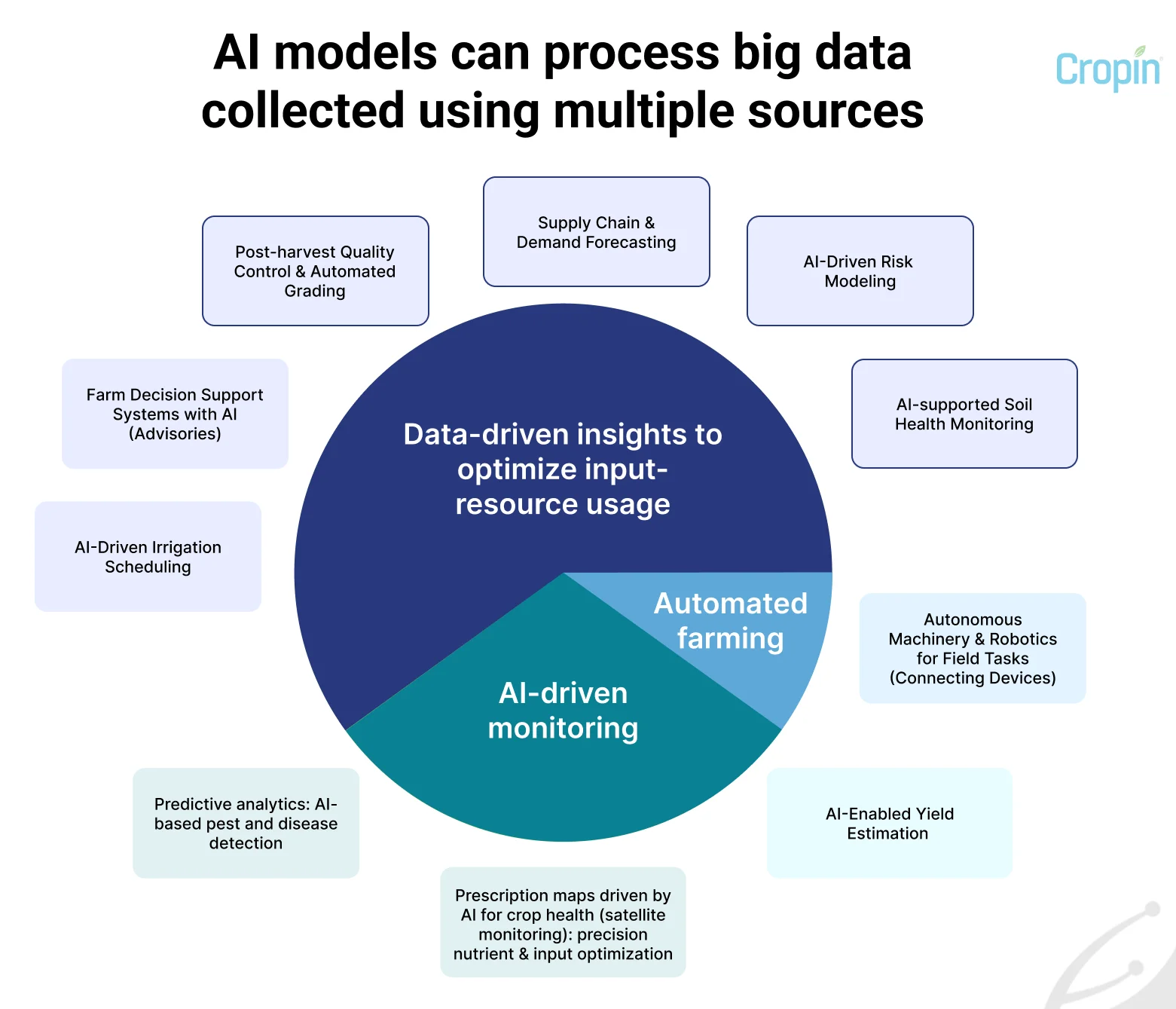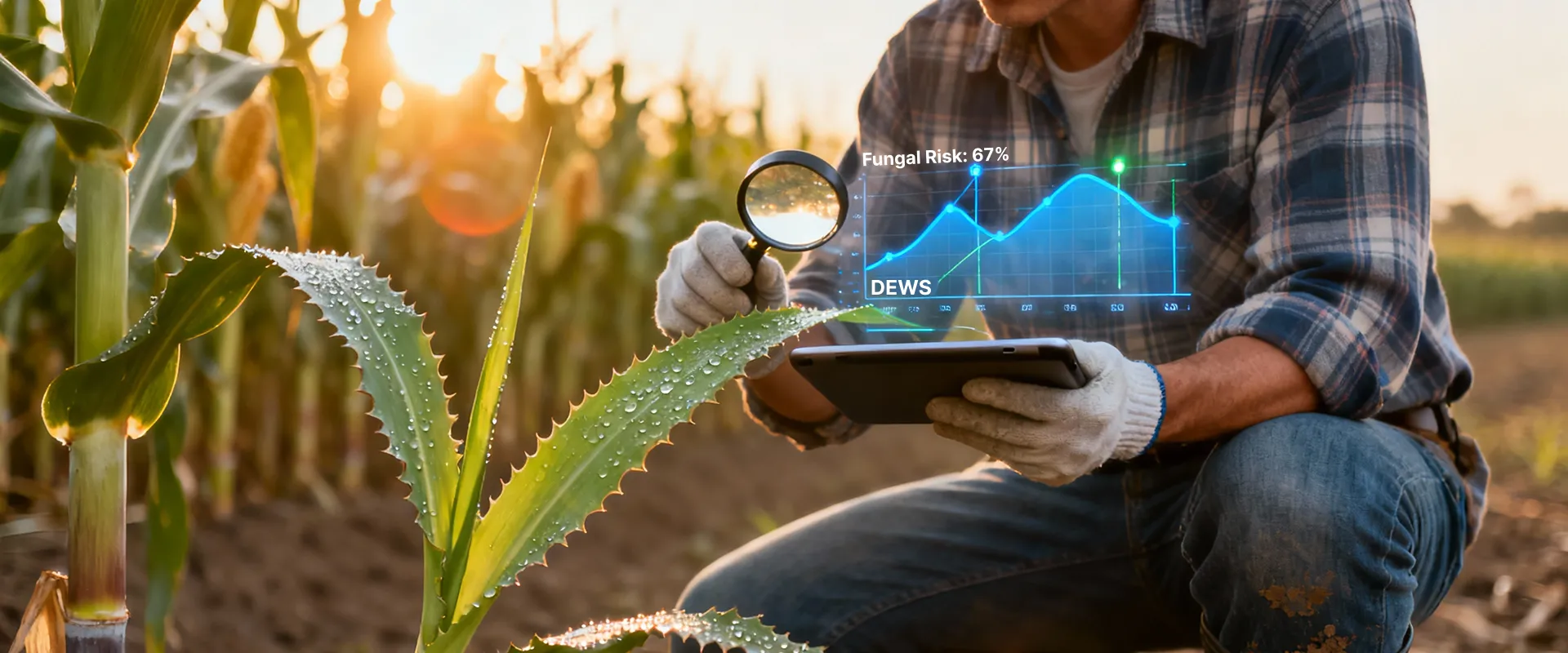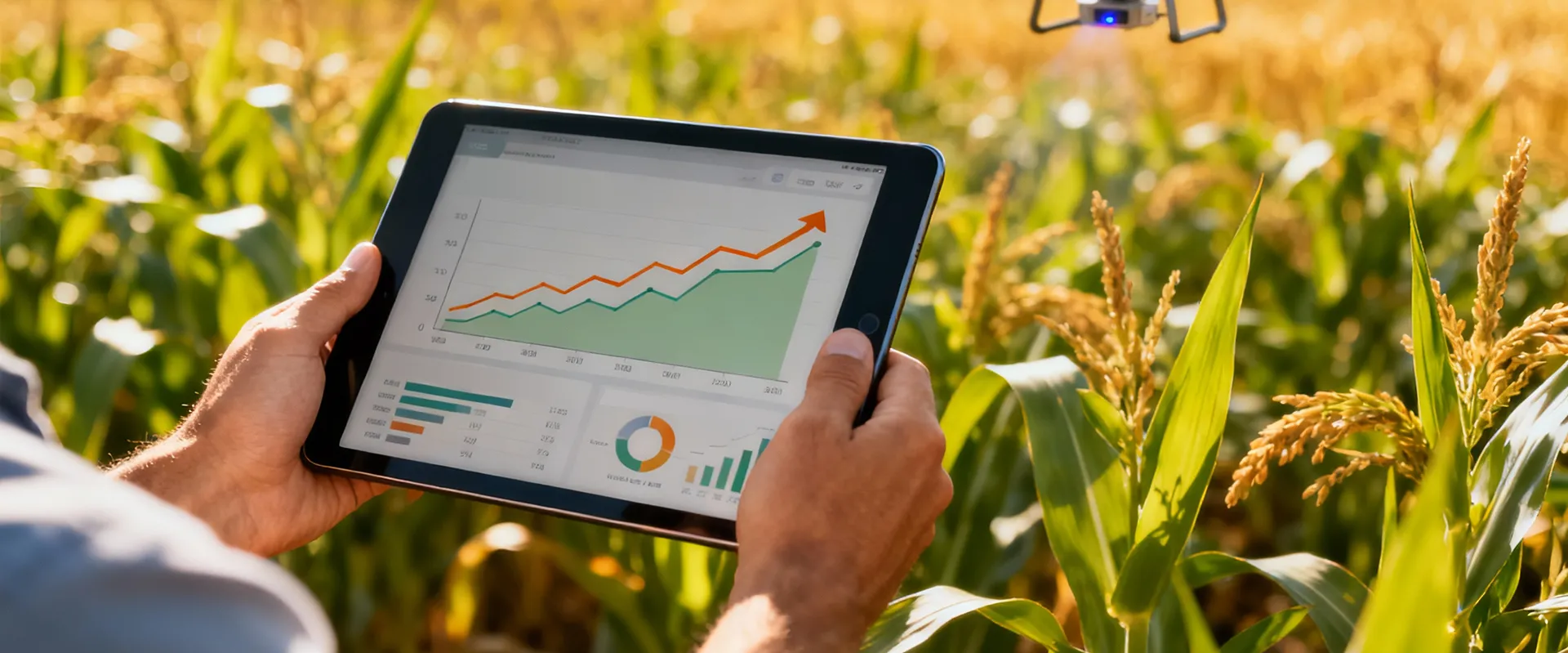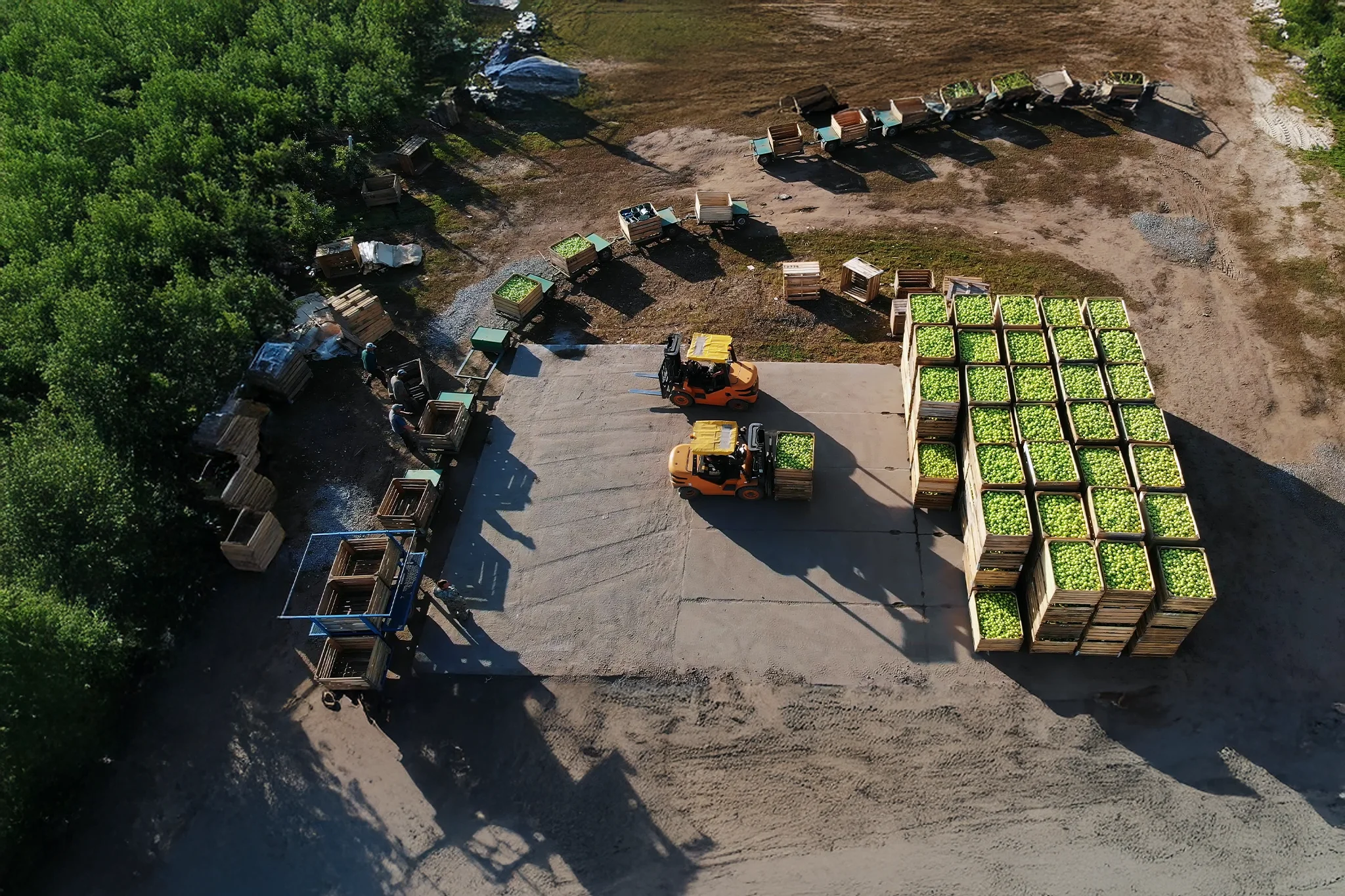Synopsis:
Why AI is the essential toolkit for global agriculture
Global agriculture is riddled with uncertainty and systemic challenges: a rapidly growing population demanding more food, escalating climate instability, and the constant pressure to conserve finite natural resources like water and soil. The traditional methods that sustained the world for centuries simply can’t keep up. The good news? Technology, specifically artificial intelligence (AI) in agriculture, offers an opportunity. The massive adoption shift is clearly reflected by the growth trends of global AI in the agriculture market, which is predicted to reach $1.8 trillion by 2030 from $136 billion in 2022.

Precision agriculture using AI: The strategic mandate
Precision agriculture is more than just using advanced technology; it is a management philosophy focused on ensuring the right input (seed, water, fertilizer, or pesticide) is applied in the right place at the right time.
If you found this blog interesting, you may also like to read Precision Agriculture for Seed Companies
Why should your company use AI in agriculture and farming: The economic case
Up until recently, AI and agriculture were never featured together. Thanks to innovative change makers, AI has revolutionized agriculture. Today, AI in agriculture is essential for data-driven decision-making that increases efficiency, sustainability, and profitability. It improves crop management with predictive analytics for planting and harvesting, early disease and pest detection, and precise usage of input resources like water and chemicals. In a world with limited arable land, these innovations are increasingly essential to feed a growing population amidst unprecedented climate change and resource scarcity.
Data: the foundation of AI-Driven farming: satellite and sensor data analytics for agriculture
Data is the new gold! And every smart decision starts with good data. The modern farm is now a living laboratory, generating petabytes of information primarily dictated by satellite and sensors. High-resolution satellite and drone imagery provide near near-real-time view, capturing the entire field and feeding information like the Normalized Difference Vegetation Index (NDVI) readings to AI models. Simultaneously, ground-level IoT sensors measure specific, real-time variables such as soil moisture, temperature, and nutrient levels. However, none of these data will be of any use for AI models if they are unstructured. So, first and foremost, the data must be structured.
Top 10 applications of AI in agriculture

The new eyes of the farm: Computer vision for monitoring
1. Prescription maps driven by AI for crop health (satellite monitoring): precision nutrient & input optimization
The traditional practice waits for a problem to appear, like a plant wilting or turning yellow. This means you have already lost yield. The goal of agri-intelligence is to act before the crop suffers. This is achieved through Predictive Analytics for Crop Health, which combines multi-spectral data from satellite imagery, field sensors, and weather forecasts. Well before irreparable damage, AI identifies changes in the plant’s spectral signature (using vegetation indices) to define crop health (active biomass, crop nutrient, and water stress). By calculating the probability of stress, the system provides crucial near-real-time alerts to take corrective measures and prevent an issue from erupting. It shifts the farmer’s role from reacting to proactively mitigating risks to crop health. AI does not stop here. With the use of zone sampling, AI enables variable rate technology (VRT) that understands the inherent field heterogeneity to calculate the chemical input required for each polygon, taking intelligence to a granular level.
2. Predictive analytics: AI-based pest and disease detection
Imagine a farmer no longer having to manually inspect thousands of plants a day, often missing a subtle fungus or a newly hatched pest. This technology removes the exhaustion and guesswork. Computer vision for crop monitoring uses neural networks trained on millions of images to achieve near-perfect accuracy in identifying specific threats. Drones or field robots scan crops, and the AI instantly flags the species of pest or the type of pathogen. This allows for immediate, hyper-localized intervention, often saving an entire harvest from disaster and drastically cutting the use of expensive, broad-spectrum chemicals. AI models also predict the probability of disease occurrence from historical data on crop disease and weather forecasts. These alerts help plan control measures and mitigate disease spread, safeguarding harvests and optimizing the use of chemicals like pesticides.
3. AI-enabled yield estimation
Accurate yield prediction is the cornerstone of all agri-food businesses. AI-enabled yield estimation models integrate remote sensing data, weather data, crop science, and more to estimate yield at major crop stages, offering critical business intelligence. Agritech companies offer a zone sampling feature that allows for accounting for field heterogeneity to improve the accuracy of yield estimation. This insight is vital to plan production, procurement, deliver sales contracts, optimize logistics, and storage requirements. Post harvests, this insight is vital to understand the harvest and plan soil preparation and sowing, and improve productivity of the next season. An increase in accuracy minimizes waste and maximizes profit stability.
Optimizing every drop and molecule
4. AI-driven irrigation scheduling
5. AI-supported soil health monitoring
Arable land, a complex living ecosystem that took eons to build, is a limited and most valuable asset for every agri-food business. Understanding its health is crucial for productivity and long-term sustainability. Soil Health Monitoring uses AI to analyze data moat satellite imagery for organic matter content, ground sensors for pH and moisture, and even lab reports from soil samples. Machine learning algorithms process this information to recommend not just what fertilizer to apply, but the variable rate needed across different zones of the field. This targeted approach saves money on inputs and fosters better long-term soil health.
6. AI-driven risk modeling
Farming is inherently risky, involving uncontrollable factors like weather and market volatility. AI provides a much-needed layer of financial and strategic certainty. AI-Driven Risk Modeling is the strategic co-pilot. It processes global commodity prices, long-term climate predictions, and historical insurance claim data to forecast financial risk. The model can suggest the optimal time to forward-sell a commodity, recommend the most resilient crop varieties for an upcoming season, and even advise on hedging strategies, moving the farm from a reactive business to a proactive enterprise.
7. Farm decision support systems with AI (Advisories)
The data resources available for agriculture are limitless; however, all this data in the world is useless if a farmer can’t quickly and easily act on it. AI models cut through the data noise to deliver clarity. Farm decision support systems (DSS) with AI (advisories) serve as the central brain. AI models integrate crop-specific intelligence, real-time field data from sensors, IoT devices, weather stations, satellite imagery, and predictive analytics, including disease probability, weather risk, and market trends. They synthesize all the data into simple, personalized notifications and recommendations delivered via mobile or web platforms. It is the intelligent translation layer, making complex data immediately actionable.
8. Post-harvest quality control & automated grading
9. Supply chain & demand forecasting
Food waste accounts for millions of dollars for agri-food businesses. AI can be deployed to stabilize the market and curtail food waste. Supply chain & demand forecasting uses AI to process everything from weather in exporting countries to supermarket sales data and social media trends. Using predictive analytics, procurement teams can identify the right region for cultivation and the right produce across each store, while the farmer gains knowledge into the right crops to grow for future market needs. This insight also helps processors and retailers optimize storage and logistics. By minimizing overproduction and streamlining the path from farm to fork, this AI application plays a critical role in global food security and waste reduction.
The automated future of fieldwork
10. Autonomous machinery & robotics for field Tasks (Connecting devices)
Fieldwork is backbreaking and often time-consuming. Robotics alleviates labor shortages and allows farm staff to focus on more complex management tasks. This goes far beyond auto-steer. Autonomous Machinery & Robotics (connecting devices), from high-horsepower tractors to specialized weeding robots, use AI and advanced GPS to operate fields 24/7. These machines are driverless and also intelligent, adjusting their speed, depth, and application rates based on the real-time soil and crop maps provided by AI-generated advisories. This integration of AI technologies for agriculture allows for unparalleled efficiency.
If you feel this blog is interesting, you may want to check out how traceability in agriculture helps track food quality







